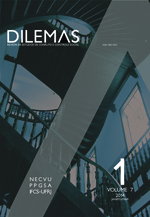Migração e violência: O ‘baiano' na construção da sujeição criminal na RMGV do Espírito Santo
Keywords:
violência criminalizada, baianos, estrangeiro, migrantes, sujeição criminalAbstract
Este artigo discute, a partir do processo de indusÂtrialização realizado no Espírito Santo, a constituição da metáfora do “baiano”, tomada como indício da violência criminalizada do estrangeiro na sociedade capixaba, principalmente do imigrante nordestino. Propõe-se aqui um estudo específico sobre migranÂtes residentes na Região Metropolitana da Grande Vitória (RMGV). A problemática apresentada consideÂra que as questões de identidade associadas a esse grupo constituem uma geografia de significados reÂferenciada nessa cidade e materializada na metáfora. E se analisam questões relacionadas à construção soÂcial do crime e da sujeição criminal de um imaginário dividido entre o “bom” e o “mau” migrante.
Based on the process of industrialization that occurred in EsÂpírito Santo state, the article Migration and Violence: The ‘Bahian' in the Construction of Criminal Subjection in the RMGV of Espírito Santo discusses the constitution of the metaphor of the “Bahian”, used to indicate the criminalÂized violence of people foreign to the state, especially those from the northeast of Brazil. It proposes a specific study on migrants living in the Metropolitan Region of Greater Vitória (RMGV). In this regard, the critique presented considers that matters of identity associated to this group constitute a referÂenced geography of meanings in this city and materialized in the metaphor. I therefore analyze issues related to the soÂcial construction of crime and criminal subjection of a geoÂgraphical notion split between the “good” and “bad” migrant.
Keywords: criminalized violence, Bahians, foreigner, migrants, criminal subjection
Downloads
Published
Issue
Section
License
Upon submitting a text, the authors retain copyright and grant DILEMAS - Revista de Estudos de Conflito e Controle Social the right of first publication, with the work simultaneously licensed under the Creative Commons License type attribution BY (CC-BY), which permits sharing of the work with acknowledgment of authorship and initial publication in this journal.

